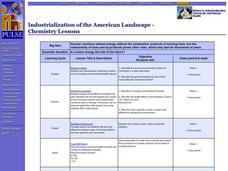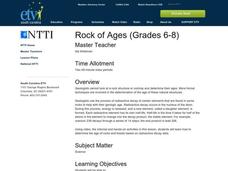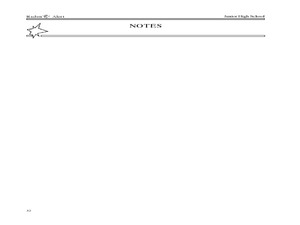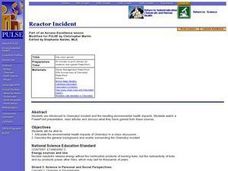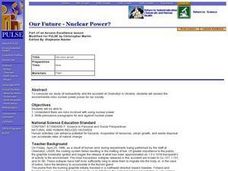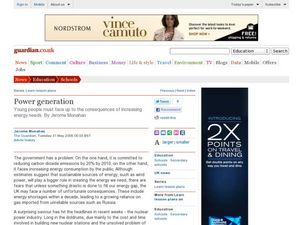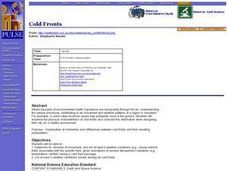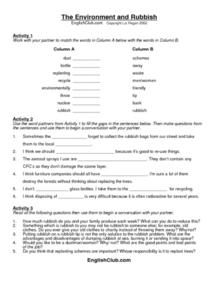National Institute of Open Schooling
Radioactive Pollution
Radioactive pollutants can enter the body through ingestion, inhalation, absorption, or injection. The last lesson in a series of 36 introduces pupils to radioactive pollution. They study its sources, both natural and man-made, its...
College Board
2004 AP® Environmental Science Free-Response Questions
Radioactive isotopes have a wealth of uses, but their waste may cause some concern. One of four free-response questions challenges learners to devise a waste removal strategy for medical radioactive substances. Other questions address...
Curated OER
Radioactivity Experiments
Students study the difference between types of ionizing radiation and how elements are transmuted. They determine that radiation is normal and surrounds us. They calculate the amounts of alpha, beta and gamma radiation emitted from a...
Curated OER
Industrialization of the American Landscape
Students explore the Chernobyl incident and the resulting environmental health impacts. They explore three different isotopes that were released into the atmosphere. Through inquiry, students determine the difference between types of...
Curated OER
Radioactive Isotopes
Students describe an isotope and radioactive isotope in a written essay. They describe how a specific country or region was affected by radioactive contamination and attempt to sympathize with those affected by these radioactive...
Curated OER
Rock of Ages
Students use a video, the Internet and hands-on activities to explore how to determine the age of rocks and fossils based on radioactive decay data.
Curated OER
Ecological Impact of River Dams
Students investigate their environment by completing an in-class experiment. In this ecological lesson, students define the roles of dams and how electricity is created by them. Students utilize plastic jugs, sand and tap water to...
Curated OER
Half Life Lab
Seventh graders model radioactive decay using pennies, collect data from their model, apply scientific visualization techniques to their data and create animated models explaining the concept of radioactive half-life.
Curated OER
Reading Comprehension- Informational Passages "Pollution"
Practice reading comprehension through this pollution learning exercise, which has learners read an informational passage on various aspects of environmental harm. Key terms are in bold, and are used on the next page in the comprehension...
Curated OER
Pollution Solutions
Students explore the role of chemicals in the pollution and destruction of ecosystems. They research factors that affect ecosystems and the methods being employed to counter them. In addition, they choose one water ecosystem that has...
Curated OER
Simulating the Greenhouse Effect in a Terrarium
Students identify what factors effect global warming and how the greenhouse effect occurs. In this environmental lesson students view videos then complete an experiment using a terrarium to observe greenhouse gas.
Curated OER
America's Energy Future
Students write a proposal to save energy resources. In this energy lesson plan, students research nuclear energy, coal power, petroleum, natural gas, hydroelectric power, and renewable energy. Students then debate energy issues and share...
Curated OER
Have You Heard about the Clinton, New Jersey Story?
In this radon worksheet, learners read about radon in the city of Clinton New Jersey. They compose a play about a family in Clinton New Jersey who is face with high concentrations of radon in their home and how they deal with it....
Curated OER
Reactor Incident
Students are introduced to Chernobyl incident and the resulting environmental health impacts they watch a PowerPoint presentation, read articles and discuss what they have gained from these sources.
Curated OER
Rain Shadows and Sea Breezes
Students plot the average rainfall for a variety of cities in the United States. Using the map, they work together to determine patterns on which toxicants are transported through the air. They determine the impacts of various weather...
Curated OER
Our Future - Nuclear Power?
Students comprehend that there are risks involved with using nuclear power. They write persuasive paragraphs for and against nuclear power. Students analyze the environmental issues and risks with nuclear power.
Curated OER
Power Generation
Young scholars examine energy issues. In this environmental stewardship activity, students discuss nuclear power options. Young scholars also discuss energy consumption and create energy reduction guides for students their own age. Many...
Curated OER
The Energy Debate - Conclusion
Pupils write a persuasive essay about the choices in the energy debate. They comprehend the environmental consequences that accompany the decision. Students predict how they will power their future.
Curated OER
Acid Rain
Students use real-time weather maps to determine the likelihood of acid rainfall in a region. Students apply their understanding of interaction between weather systems, land and air pollution, to address acid rain and the effects on...
Curated OER
Cold Fronts
Students determine its' direction of movement, and list at least five weather conditions associated with the specific front, given animations of several atmospheric variables during a cold front passage. They list at least three weather...
Curated OER
The Environment and Rubbish
Students complete matching, short answer, and fill-in-the-blank questions regarding garbage and the environment. Some thought-provoking conversation starters are embedded in the plan which should lead to some meaningful discussion...
Curated OER
Air Masses
Students examine the physical characteristics of several types of air masses to discover how air masses can be identified and defined by their temperature and moisture content.
Curated OER
The Great Hungarian Toxic Disaster
Ninth graders examine the the toxic spill in Hungary. In this Hungarian lesson plan, 9th graders read an article and answer guided questions. Students write an email to their teacher explaining the causes and effects of the Toxic disaster.
Curated OER
Polishing the Petoskey
Students select a stone and polish it. Throughout the process they demonstrate an understanding of rocks and fossil formation.





